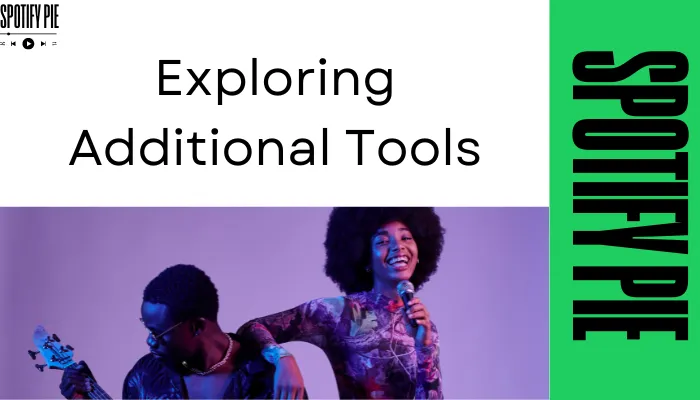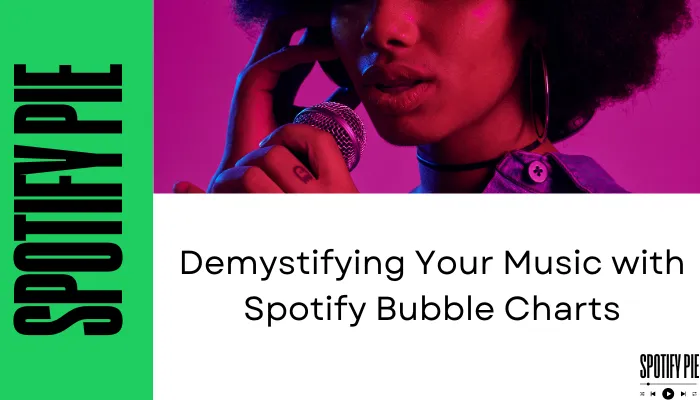In this fashion though any Spotify bubble chart can be made dynamic and interactive to represent individual taste in music.

Music is a universal language that surpasses the boundaries of countries and evokes feelings. However, have you ever thought about your music preferences? What kind of genres do you prefer? Whose songs are playing on your playlist most frequently?
This is where data visualization comes in handy, providing an interesting way to analyze your musical tastes using Spotify Bubble Chart. Think about a spreadsheet filled with all your Spotify listening data – tracks, artists, genres, play counts.
Unveiling the Secrets of Spotify Bubble Chart
Bubble charts form a specific type of data visualization that utilizes colored circles of various sizes to symbolize multiple data points. Here’s how they work:
| Aspect | Description |
|---|---|
| Circles | Each bubble on the chart depicts one point in time or activity such as Spotify Pie chart artists, songs, or genres. |
| Size Matters | The size of your bubble indicates its value within the set. For instance, when using Spotify Bubble Charts bigger bubbles may connote frequent Spotify Pie chart artists plays. |
| Color Coded | You may assign colors to represent additional data points; these could be genre classification (blue for pop, green for rock), mood (yellow for upbeat, purple for mellow), or even release year (brighter colors for newer releases). |
Benefits of Bubble Charts
Engaging and Easy to Understand: These charts are visually appealing and self-explanatory making them easily understandable by everyone whether it’s statistics analysts or even people who listen to music casually.
Multifaceted Analysis: By using size and color to represent multiple data points at the same time, bubble charts allow for a more nuanced understanding of your music preferences.
Pattern Recognition: They reveal unnoticed patterns such as your preference for a specific kind of mood within a certain genre.
Unveiling Your Musical Identity with a Spotify Bubble Chart
Let’s now take an exciting journey into the world of Spotify Bubble Chart. With this interactive visual tool, you will be able to see how often you listen to different artists on Spotify.
- Concept: Consider an example where every artist you listen to is represented by a bubble on the chard. The bigger the bubble, the more likely you are to play their songs. In addition, the color of each circle may indicate its assigned genre.
- Visualizing Spotify Data: When using Spotify Bubble Charts, it takes seconds to see which artists dominate your playlist. For instance, when you see larger bubbles representing your favorite musicians then it’s obvious they would be the first that catches your eye while another coloring can unmask genres like pop or rock or a mixture in between.
- Importance in Music Analysis: It reveals more about what an individual’s favorite artists list than simply listing them does. For example, one may realize that there is a cluster made up of many big bright (indicating recent releases listened to very often) circles within one genre meaning that he/she has been recently exploring it.
Exploring Additional Tools
Spotify Bubble Charts are different, but you can also try other data visualization tools: These charts visually indicate the percentage distribution of your music tastes. Each segment represents a genre or Spotify Pie chart artists and the biggest slice shows your most preferred choice.

Utilizing these tools in the union will give you a complete picture of who you are musical. The Spotify Bubble Chart reveals what your listening patterns display thus; while pie charts provide an overview about which genres you love most.
Therefore, plunge into the world of data visualization and understand what your music library hides! You can investigate your musical preferences with the help of Spotify Bubble Charts, keeping track of emerging trends and going deep into the songs that shape our lives.
How to Unveil your Music DNA through Spotify Bubble Charts?
Understanding your music preferences in the age of streaming giants can be an interesting process. In respect to this, Spotify, the popular music platform becomes a data goldmine for information about what you listen to.
Nonetheless, interpreting such data is often challenging. Thus comes in Spotify bubble chart; a dynamic graphic tool that turns listening patterns into colorful and meaningful pictures.
Decoding The Chart
A Spotify bubble chart is a graphical representation of your music tastes with bubbles denoting artists or genres or songs you listen to. The key components include:
| Axis | Description |
|---|---|
| X-axis | Can represent various elements of your music e.g., danceability, energy, or acoustics. The position of a bubble along this axis indicates the score that an artist or song has for that metric. For instance, if an artist is positioned towards the right on the “danceability” axis it could suggest that you have more energetic songs from him/her in your playlists. |
| Y-axis | Like the X-axis, the Y-axis may also represent another aspect of music. It typically represents popularity among Spotify Pie chart artists on Spotify where higher bubbles along the Y-axis signify more popular ones. |
| Bubble Size | There are no random sizes of bubbles here! Everyone corresponds to a specific index usually the number of times played that given artist’s song during the selected period – bigger ones meaning their songs or musicians frequently listened to by you. |
| Color Coding | This adds another layer of information. Colors can categorize songs according to their genre (pop, rock, etc.) or mood (energetic, mellow). Using color well the chart gives richer information about your musical taste. |
Data Collection and Generation
With these building blocks in mind, let us now discuss how you can create your personalized Spotify bubble chart.
- Data collection: The initial step involves gathering all Spotify listening data. Luckily for us at the end of every year, Spotify provides a “Spotify Wrapped” service that will give you details of your top artists, genres, and songs.
- Tools and Software: Once you have collected the required data, there are various online tools and software that one can use to generate a Spotify Bubble Chart. These offer several options for customization; you are able to select specific points in order to visualize them on their charts while also having control over their appearance.
| Step | Description |
|---|---|
| Collect your data | Make use of both Spotify Wrapped as well as 3rd party providers to gather your music listening data. |
| Choose a visualization tool | Check out some online ones or go for software that suits your requirements. |
| Import your data | Follow the instructions given by the software on how to upload it. |
| Personalize your graph | Highlight what aspects from this huge dataset would matter most when designing such; include an X-axis & Y-axis label where relevant. |
| Scale bubble size and color coding | Clarify what the size and color signify (play count, genre, etc.). |
| Make a chart for you | Let the tool create your personalized Spotify Bubble Chart! |
Analysis and Interpretation
Now this is where it gets interesting – explaining what your Spotify Bubble Chart shows about how you like to listen to music.
- Interpreting Bubble Positions: What do the X and Y-axis labels suggest? Do your favorite artists cluster at certain energy levels or danceability scores? This indicates a preference for high-energy music or an inclination towards slow-tempo tunes.
- Understanding Bubble Sizes: If one bubble is larger than another, that means that an artist or song has been played more often than others. In this way, it reflects which songs you play most frequently and reveals some hidden gems.
- Extracting Insights from Color Coding: Whether genres or moods are assigned colors, you can know how much specific genres represent in your listening experience or identify what moods usually draw you closer.
Remember: It’s not about looking right or getting it wrong with your Spotify Bubble Chart; just how unique it is as an expression of who you are musically. Share with friends and compare charts to see who listens to what more often, and discover new bands similar to yours among other things using Spotify charts.
Demystifying Your Music with Spotify Bubble Charts
The age of streaming has created a large and dynamic music library. How then do we understand our listening habits? This is where the Spotify Bubble Chart comes in.

This article takes a look at Spotify Bubble Charts, their uses, limitations as well as how to make the most out of them. Eventually, you will be able to design and interpret these graphs so that they can give insights into your unique sound landscape.
The Power of Spotify Bubble Charts
Spotify Bubble Charts are more than just lists composed of your favorite genre or artists; they provide rich details about certain trends that may have escaped you before. Here’s how:
- Discovering Music Popularity Trends: Picture bubbles representing artists or songs, with larger ones indicating greater popularity on Spotify (measured by number of streams or other means). Through this, one can tell which musicians dominate charts and whether one’s favorites match up.
- Analyzing Genre Preferences: The bubbles in Spotify Bubble Charts can be sorted according to genres. You can easily observe the distribution of genres in your collection. Do you listen mainly to one genre or is there a wider variety?
- Exploring Artist Popularity and Influence: Collaborations or shared influences are some pieces of data that when added onto it would show relations between artists through their presence within favorite artist bubbles. For example, imagine smaller bubbles linking together favorite artist bubble features that link them to the other artist.
Remember, Spotify Pie Charts provide a complementary perspective. However, whereas they show how artistically pervasive certain genres or musicians are, Bubble Charts add another layer of detail through size.
Limitations and Challenges
Spotify Bubble Charts are great but still have some limitations as illustrated below:
The chart depends on the data source being used in its creation. It is possible that free tools might have less data while paid ones offer more options. Furthermore, the data points chosen (streams, followers, etc.) can completely change the meaning of the chart.
Understanding a Spotify Bubble Chart will take some practice just like any other kind of data visualization method. The initial view of numerous bubbles and their relationship with each other can be overwhelming. Take time, identify trends, and look at the graphic legend for explanation purposes.
Tips for Effective Use
To maximize benefits from Spotify Bubble Charts observe these suggestions:
- Choosing Appropriate Data Parameters: Let us decide if we want to know about the popularity of music, genre distribution, or artistic affinity. Choose data points (streams, followers, etc.) that contribute directly to your aims
- Modifying Bubble Chart Settings: The majority of the tools allow users to customize how they want the chart to look. This can be accomplished by modifying bubble size, transparency, and color hence emphasizing some trends.
- Interpreting Results Correctly: You should not take everything you see from the chart at face value. Look for patterns but do not ignore limitations such as data sources or any biases that might be present. Use it as your primary point for more exploration.
Conclusion
Spotify’s bubble charts are a fun and clever means of exploring your listening taste. By understanding their applications, limitations, and how to use them effectively, however, we can become aware of new music and appreciate our own unique preferences even more deeply.
So next time you’re checking out Spotify, think about making a Bubble Chart. You may well find interesting hidden trends and links that will lead you down exciting new avenues in the vast world of music.
Always remember, Spotify bubble charts in particular keep changing. Watch out for improvements on features and functionalities in Spotify bubble charts useful during your exploration of music!
